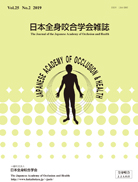The purpose of this study was to clarify the conditions for adequately testing the masticatory performance and occlusal force of adults with missing unilateral molars. Twenty females with missing molars on one side (unilateral molar loss group) and 20 females with natural dentition (control group) participated in this study. The amounts of glucose eluted when the participants chewed a gummy jelly on the habitual and non-habitual chewing sides were measured. Furthermore, using an occlusal force analysis system (Dental Prescale II, Bite Force Analyzer, GC, Tokyo, Japan), the occlusal force on the habitual and non-habitual chewing sides during maximum clenching (lasting about 3 seconds)(hereinafter referred to as occlusal force) was measured. For the amount of glucose eluted and the occlusal force, the presence or absence of a correlation between the habitual and non-habitual chewing sides was investigated. Next, the presence or absence of a correlation between the amount of glucose eluted on the habitual chewing side and the occlusal force on the habitual chewing side and between the amount of glucose eluted on the habitual chewing side and the occlusal force on the entire dentition (both sides) were investigated. In both the unilateral molar loss group and the control group, a significant correlation was observed between the amount of glucose eluted on the habitual chewing side and the amount of glucose eluted on the non-habitual chewing side, and between the amount of glucose eluted on the habitual chewing side and the occlusal force on the habitual chewing side. In the control group, there was a significant correlation between the occlusal force on the habitual chewing side and the occlusal force on the non-habitual chewing side, and between the amount of glucose eluted on the habitual chewing side and the occlusal force on the entire dentition. However, no significant correlation was observed in the unilateral molar loss group. It was suggested that both masticatory performance and occlusal force should be analyzed on the habitual chewing side instead of the entire dentition.
View full abstract
